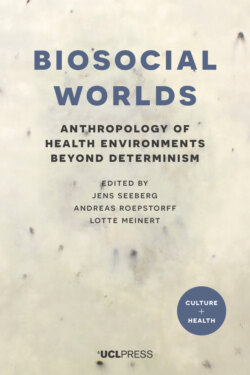Читать книгу Biosocial Worlds - Группа авторов - Страница 11
На сайте Литреса книга снята с продажи.
Health environment
ОглавлениеFor several decades, up to the completion of the Human Genome project in 2003, the nature–nurture debate that had been central to early American anthropology seemed to have tilted to the advantage of the ‘nature’ position, leaving only a limited space for critical dialogue. The Human Genome project was celebrated as ‘nature’s complete genetic blueprint for building a human being’ (National Human Genome Research Institute 2015). Perhaps paradoxically, this achievement contributed to a realisation that the implied genetic predetermination of human lives and human behaviour was vastly exaggerated within the Darwinian paradigm. This led to the return of the field of epigenetics that explores the interaction between environment and activation or deactivation of genetic dispositions that influence the individual human life – and potentially the lives of subsequent generations (see Lock, this volume; Napier, this volume). Such new understanding of the malleability of human biology potentially undermines the century-long insistence within the fields of medicine and epidemiology on the universality of human biology. It calls, instead, for an understanding of local biologies, as first proposed by Lock, implying that ‘differing accounts about biological ageing are not simply the result of culturally shaped interpretations of a universal physical experience but the products […] of an ongoing dialectic between biology and culture in which both are contingent’ (Lock 1993, xxi).
At first glance, it seems as if the move from genetics to epigenetics should signal a drive to understand the role of the environment in the development of an organism, whether human or non-human. However, as pointed out by both Lock and Niewöhner (this volume), the epigenetic framework remains predominantly a genetic perspective. Although the environment enters into the genetic, co-determining what is being expressed and how the organism is shaped, it does so via a molecular mechanism, for example, as the phosphorylation of DNA or modification of histone complexes. Seen from within this framework, the environment ultimately becomes molecularised, that is, the environment exists to the extent that it can be traced as a variable that shapes a particular molecular configuration, and hence changes the properties of the genome.
Radicalising this claim, one may argue that epigenetics teaches us something new and valuable about genetics, but it is difficult to see how it could scale up to be the general story of how organisms and environments interact. Instead, Niewöhner argues, we should go beyond both a ‘gene-centric’ and an ‘environment-centric’ approach to identify the particular practices that dynamically shape both environments and genes. Such an approach may trace its pedigree from a long lineage focusing on ‘natural history’, and may ultimately be Aristotelian in the focus on habits (Atran 1993). It argues for a customary biology (Niewöhner 2011), that is, a biology which shifts the analytical focus away from genes and environment to how customs, or patterned practices (Roepstorff et al. 2010), may shape environment and genome. In this understanding, the notions of ‘health’ and ‘environment’ are entangled in a way that moves their relation beyond interdependence to one of inseparability. The subtitle of this volume captures this insight through the concept of ‘health environment’.
‘Health environment’ may, we believe, allow for a fresh analytical perspective on Lock’s notion of local biology. This is beautifully illustrated in Svendsen’s analysis (this volume) of pigs as experimental model animals in a Danish context. Already, the ordinary Danish pig, ‘with leaner meat, an extra rib and large litters’, is an instance of a local biology, which is currently being exported to the rest of the world. The Danish pigs are the result of highly specific practices of breeding based on systematic selection. Underlying mechanisms, most likely not only – if at all – epigenetic, shape the genetic makeup of the pig, and go hand in hand with a specific environment in which the pigs are reared. The general case of the local biology of the Danish pig is taken a step further in the laboratory practices Svendsen studies. Here, the local biology of immature piglets born prematurely by Caesarian section become models of weak infants at risk of potentially devastating inflammation of the gut, thus ideally improving the health of preterm human infants worldwide. Paraphrasing Willerslev, it is the piglet’s status as non-human on the one hand that makes it ethically justifiable to force early birth on the piglets and ultimately kill them, while their existence as non non-humans on the other is the rationale for making them model animals in the first place, so comparable to infants that findings may be generalised from one species to the other (Willerslev 2004).
While this case certainly involves genes and environments in very specific and dynamic configurations, the engine infusing energy into these interactions can be found neither at the level of genes nor of environment. Rather, it is embedded in very particular networks and institutions of power, interest and intentions. Failing to take these into account means failing to identify critical factors shaping both environment and genes.
